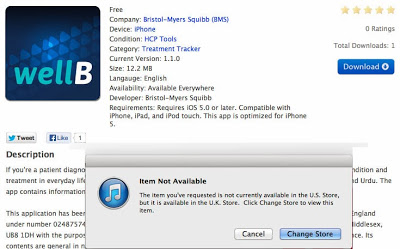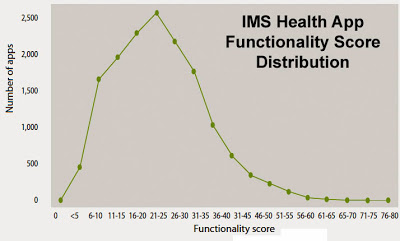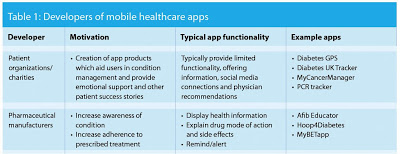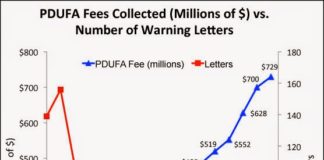There are several stories out this morning about mobile health apps in general and pharma health apps in particular. (Keep reading to learn about the app I cannot download 🙂
First, let’s look at the IMS Institute for Healthcare Informatics report “Patient Apps for Improved Healthcare: From Novelty to Mainstream” (download it free here). This report includes an analysis of a subset of the 40,000+ healthcare apps available for download from the U.S. Apple iTunes app store and an assessment of the potential value they provide throughout a patient’s journey. “An assessment finds that healthcare apps available today have both limited and simple functionality,” say the authors of the report. “The majority do little more than provide information.”
Each app was given a “functionality score” based on 25 criteria, which include the type and quantity of information provided by the app, how the app tracks or captures user data, etc. So, how did the apps do, functionality-wise? Here’s the functionality score distribution curve:
Not very good. You’ll notice that this is not even a “normal distribution” in which scores would tend to group around a central value with no bias left or right. This curve has a strong bias to the left — low score — region. In fact, more than 90% of the over 16,000 consumer health apps studied received a score of 40 or less. Looking on the bright side, 1,600 apps scored between 40 and 80 or maybe 60.
IMS, however did not look at some criteria that I would consider important.
For example, IMS did not evaluate whether or not the information provided by 10,000+ apps was accurate and supported by references to reliable sources.
One of the guiding principles of the eHealth Code of Ethics — which I helped create — states that health sites should “Provide health information that is accurate, easy to understand, and up to date” and, specifically, “indicate clearly whether information is based on scientific studies, expert consensus, or professional or personal experience or opinion” and tell users “what sources the site or content provider has used, with references or links to those sources” (find the principles here). Although this code was written before the mobile app era, it should apply to mobile as well as Web sites, which are becoming one and the same these days — it’s all “eHealth.”
What about pharma health apps for consumers? How do they score?
IMS did not break out pharma app scores in the published study. They did note, however, that pharmaceutical apps tended to display health information, explain drug mode of action and side effects, and provide reminders and alerts (click on table below to read more).
Although IMS did not look at physician apps, you would expect that these apps should provide the most “accurate” and “up to date” information that is well-sourced and documented. But that has NOT been the case for several of the pharma HCP apps that I have reviewed (read, for example, “Some Unregulated Physician Smartphone Apps May Be Buggy“). In fact, in January 2012, Pfizer “recalled” its Rheumatology Calculator app because of “a bug in the app … gives wrong results” and issued a “dear doctor” letter that probably did not prevent the use of the app by many physicians (read “The First Ever ‘Dear Doctor’ Letter Regarding a Mobile Medical App Recall“).
IMS noted “a significant skew in download volume for healthcare apps, with more than 50% of available apps achieving fewer than 500 downloads. Conversely, 5 apps account for 15% of all downloads in the healthcare category.” IMS did not mention, however, that even when healthcare apps are downloaded, they may be used once and then forgotten about for one reason or another.
I personally have downloaded one of the apps mentioned by IMS, used it once and then never again. I recently “voiced” my criticism of this and another pharma app via a Truvio mobile-enhanced survey. Listen to this:
Your browser does not support the audio element. Upgrade your browser to one that does
You can learn more a boy Truvio by listening to this podcast: “Mobile-Enabled Patient Focus Groups – Truvio Emphasizes the Importance of Patients’ Voices.”
Sometimes, pharma apps are impossible to download in the U.S. despite being “advertised” as “Available Everywhere.” One such app is WellB, which was created by BMS and promoted on POCKET.MD (here). According to the description, WellB helps patients with Hepatitis B manage their condition and treatment “in everyday life. The app is available in: English, Bengali, Chinese, Filipino, Hindi, Polish, Russian and Urdu. The app contains information on the disease and treatment.”
Unfortunately, WellB is only available through the UK iTunes store, not “everywhere” and not in the U.S. store where I have an account:
This has happened to me before and it’s very frustrating. Why do global pharma companies tease us like this? Perhaps this is just another case of a poor launch of a health app by a pharmaceutical company.











![6 Digital Tools at the Center of Healthcare Digitalization [INFOGRAPHIC]](http://ec2-54-175-84-28.compute-1.amazonaws.com/pharma-mkting.com/wp-content/uploads/2021/04/6DigitalTools_600px-100x70.jpg)




